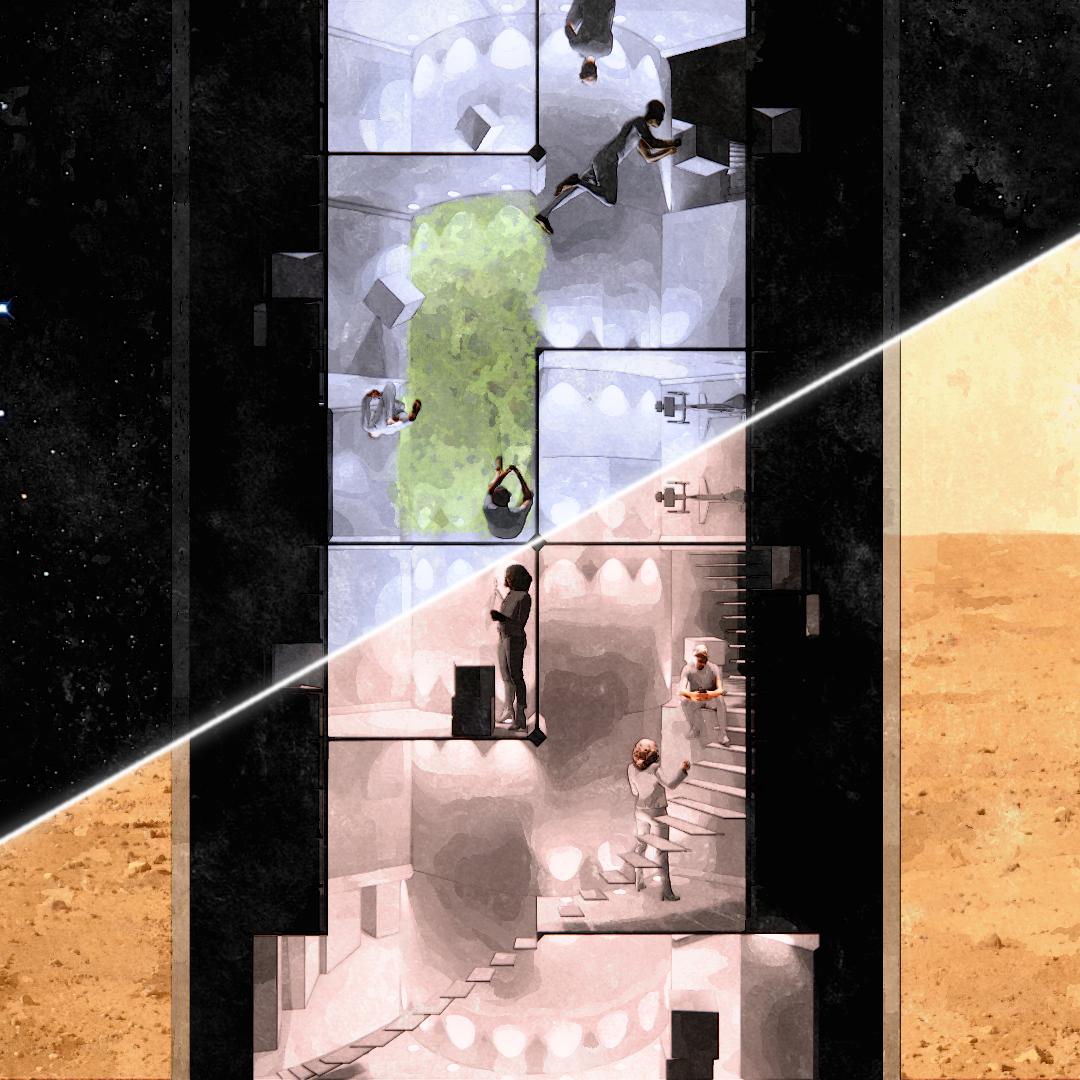Project Helix is a speculative spatial concept for SpaceX's upcoming human-rated Starship which focuses on practicality, efficiency, and experiential quality.
Classification: Z1i
Project Helix - v.2 Update
2021.07.21
Project Helix
2021.03.22
There seems to be a trend of designing speculative interiors for the SpaceX's upcoming Starship. It's large size and blank-canvas nature lend itself to being the object of imagination for all matter of speculative designers and techno-optimists. I view many of the aforementioned designs the same way I view speculative renderings of towering vertical farms and glass-domed moon habitats: lacking in rigor and excessive in sex appeal. That being said, I'd like to try my hand at a concept for how to organize spaces for long duration, high capacity journeys in the blank canvas that is the SpaceX Starship.
The name for this project is derived from the double helix structure of the corridor connecting the community areas, quarters, and support space units. The goal of this project was to explore the opportunities for unique spatial organization that is efficient, practical, and appropriate for all the environments that the Starship will be in.
The conceptual layout has the crew quarters located in the central column oriented radially. It is important on long-duration missions with many people in close quarters that each individual is provided a space of their own. This is why designs with an entire deck filled with lounge/launch chairs will not work long term. The larger group areas are located closer to the nose portion, where any desired portals might be located. These open areas are also important for long-term travel, as it’s easy to become claustrophobic in a tight, enclosed space (not even submarine trips last 6 months). There is plenty of storage and activity/functional spaces available and accessible along the corridors.
Key Features:
Gravity-Agnostic Organization
The speculative designs for the Starship interior have so far been generally organized in levels. The instinct to do this makes sense since we have lived all our lives in structures with clearly delineated levels or floors. That being said, the distinction between floors or walls or ceilings in microgravity is mostly conventional as opposed to practical. The spatial organization of the human-rated Starship interior should not be as strongly constrained to the organizing principle of levels to the extent of those that dominate the current speculative designs of the Starship interiors. A strict adherence to floors carries little weight in space (presuming the mission will be undergone without artificially simulating gravity). Even when Starship has landed and is vertically upright on Mars or the Moon, there is less of a burden to bare under the diminished gravity when traversing the ship vertically when compared to doing the same task on Earth.
In Project Helix, spaces are organized in a way that is somewhat agnostic to gravity, but which also can be traversed under gravity when the time calls for it. This is accomplished my combining lateral and axial circulation into two spiraling corridors. In space they are mere passageways, but under gravity they become stairways for crew and cargo. The agnostic organization allowed by microgravity fosters more creative and efficient ways to use the occupiable spaces than that of the same program of spaces based on floors, as any surface in microgravity can be a working or otherwise occupiable surface (not just floors).
Option for Diversity
The indicated quarters and support space units are able to form this structure partly because they are of various sizes and shapes. Having varied forms of quarters is important for a diverse clientele, especially for long duration journeys such as those going to Mars. In a pay-per-ride based business model (such as space tourism), the benefits of quarter variation extend to both the client and the provider alike; the client benefits from varied options that suit their preferences and budget, while the provider benefits from the constancy of economy clients and the higher revenue per unit volume of the premium clients.
Diversity in size also supports the sharing of quarters by travel companions. Depending on the specific design, the sharing of larger quarters might also be more space-efficient than individual quarters. Such individuals might be coworkers, friends, or even romantic partners.
While a diversity in sizes of quarters is possible in the Helix concept, it is not necessary for the employment of this concept. If a more egalitarian program is required/requested (ex: a one-way ticket to Mars for the purpose of community building), the quarters can be made to be uniform in volume and rough dimensions.
Non-linearity
Whether a structure will experience Earth gravity, sub-Earth gravity, or microgravity, it is important to avoid designing the habitable spaces with an overextended linear proportion along the axis, such as a central ladder/stairway. In other words, straight axial shafts should be avoided. There are a couple reasons for this. One is that of the disorientation that comes with experiencing long proportions in microgravity as detailed here. In short, such extreme proportions can lead to the sensation that one is falling, which can be psychologically distressing (even for trained astronauts, let alone uninitiated civilians). Another reason to avoid extreme proportions (especially axial ones is that while the ship is on the surface of Earth, Mars, or the Moon, the long passages intended as corridors in microgravity become vertical shafts that may be more difficult to traverse.
Instead, a better solution should function under gravity and microgravity alike. This design requirement would then support the stepped spiral corridor configuration employed in Project Helix. Such a corridor would allow safe vertical transit in the vehicle when under gravity while interrupting the long views that cause disorientation in microgravity. The upper storage areas of the ship would also be easier to unload with such a set of stairs as opposed to a series of ladders.
Diagrammatic concept for multiple corridors.
Multiple Passageways
This is a consideration that may not occur to those who don't professionally design spaces for human habitation, but safety and usability should be considered paramount in the interior design of a habitable space.
One safety (and practical) consideration would be whether or not there are redundant passageways and egress. There is a reason that airplanes have multiple emergency exits and why there is a building code limit to the length of dead-end corridors in buildings. If there is an obstruction in a passageway during an emergency, it might prevent individuals from egressing to a safe location. Also, each passageway has a practical capacity, and a single passageway may not be enough when there may be as many as (100) people needing to egress the space. These circumstances in an airplane or a building on Earth might lead to loss of life if rescue teams are not able to intervene, but there are no rescue teams in space. Because of this, an individual in space or another extraterrestrial body who cannot egress to another area in the event of an emergency has an even higher likelihood of death. It is for these reasons that multiple passageways would be recommended for the starship interior.
Project Helix is host to two passageway corridors, each spiraling along the length of the Starship interior as a double helix structure in the DNA molecule. These passageways can be connected at each end, creating a twisted loop corridor.
Appropriate Structural Grids
The organizing geometry for a prospective interior design should respond to the structural design of the barrel structure of the Starship. In the current design of Starship, the structural spokes are set at 60 degrees creating six equal segments. It follows then that the internal layout should respond to these partitioning spokes to simplify the lines of force. Many of the speculative interiors do include radial walls, but they do not always follow the 60 degree pattern. Still other interior designs offer no interior support solution whatsoever.
Given the circular profile, the elongated axis, and the axial/lateral loads, a combination radial and concentric grid would best respond to the profile and the forces on the interior elements. Since the exterior barrel also functions as the sheer-resisting support, the interior structure needs only to resist axial and lateral loads with simple pinned connections (though moment connections could be used if redundant rigidity is recommended).
Project Helix uses axial, radial, and concentric grid lines to organize the interior spaces. The structural system employs axial columns and radial/concentric beams that follow the grid lines along with all necessary services that need to be plumbed throughout the interior such as air, water, waste lines, power/data cables, etc. In this way, the interstitial spaces between the occupiable spaces can either be minimized or used for other purposes.
















